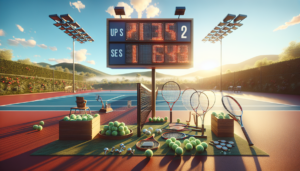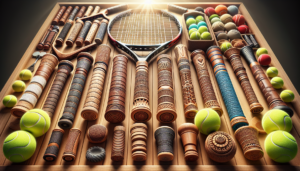Introduction to Types of Tennis Shots
Tennis is a dynamic sport that requires mastery of various shots to excel on the court. Each type of shot has its own unique characteristics, techniques, and applications in the game. Understanding and executing these shots effectively can greatly enhance a player’s overall performance and strategy.
From powerful forehands to delicate drop shots, the diverse range of tennis shots allows players to adapt to different situations and outmaneuver their opponents. Mastering these shots involves a combination of proper technique, footwork, timing, and practice. By developing a strong foundation in the fundamental shots, players can build a well-rounded game and become formidable competitors on the court.
In this comprehensive guide, we will explore the different types of tennis shots, including the forehand, backhand, serve, volley, half-volley, lob, overhead smash, slice, drop shot, and passing shot. We will delve into the techniques, strategies, and drills associated with each shot, providing valuable insights to help players of all levels improve their skills and elevate their game.
Forehand Shot
The forehand shot is one of the most fundamental and powerful strokes in tennis. It is executed by swinging the racket across the body with the dominant hand, striking the ball on the same side as the hitting arm. A well-executed forehand can generate significant pace and topspin, making it a go-to shot for many players during baseline rallies and aggressive play.
Developing a strong and consistent forehand requires proper technique, including a good grip, stance, and swing path. Players often use a semi-western or western grip for their forehands, allowing them to hit with more topspin and control. The swing path should be low to high, brushing up the back of the ball to create topspin and increase margin for error over the net.
Technique and Execution
To execute a proper forehand shot, start with a balanced stance, with feet shoulder-width apart and knees slightly bent. Turn sideways, with the dominant hand gripping the racket and the non-dominant hand supporting the throat of the racket. As the ball approaches, take the racket back, keeping the elbow close to the body and the wrist relaxed.
When striking the ball, extend the arm forward, making contact with the ball in front of the body. The racket face should be perpendicular to the ground or slightly closed to generate topspin. Follow through the shot, finishing with the racket over the opposite shoulder. Proper weight transfer from the back foot to the front foot is crucial for generating power and control.
Practice drills focusing on forehand technique, such as hitting against a wall or with a partner, can help ingrain proper mechanics and improve consistency. Vary the drills by hitting cross-court and down-the-line shots, as well as practicing forehands on the run to simulate match situations.
Common Mistakes and How to Avoid Them
One common mistake in forehand technique is having an improper grip, which can limit wrist flexibility and shot control. Ensure a comfortable and secure grip that allows for a full range of motion. Another mistake is rushing the shot, resulting in a shortened backswing and loss of power. Focus on a smooth, deliberate backswing and forward swing, allowing time for proper preparation.
Footwork is also crucial for effective forehand shots. Failing to get into the correct position can lead to awkward and off-balance shots. Practice proper footwork drills, such as side-to-side shuffles and quick steps, to improve agility and court coverage. Anticipate the ball’s trajectory and adjust your position accordingly to set up for a solid forehand.
Lastly, avoid over-hitting or trying to generate too much power, as this can compromise accuracy and consistency. Focus on controlled, well-placed shots rather than sheer force. Gradually build up power as technique improves, maintaining a balance between pace and precision.
Backhand Shot
The backhand shot is another essential stroke in tennis, hit on the opposite side of the body from the dominant hand. It can be executed with either a one-handed or two-handed grip, depending on player preference and style. The backhand is crucial for defending against shots directed to the non-dominant side and can also be used offensively to create angles and control points.
Developing a strong backhand requires a combination of proper technique, footwork, and practice. Players must learn to adjust their grip, stance, and swing path to accommodate the unique challenges of the backhand shot. Regular drills and repetition can help build muscle memory and improve consistency on both the one-handed and two-handed variations.
One-Handed vs. Two-Handed Backhand
The choice between a one-handed or two-handed backhand often comes down to personal preference, physical attributes, and playing style. The one-handed backhand allows for greater reach, variety of spin, and a more classical style. It requires strong wrist and arm strength to generate power and control. Players like Roger Federer and Justine Henin are known for their elegant and effective one-handed backhands.
On the other hand, the two-handed backhand provides more stability, power, and consistency. It involves gripping the racket with both hands, with the dominant hand at the base and the non-dominant hand above it. The two-handed backhand is often easier to learn and execute, making it a popular choice among modern players. Notable practitioners of the two-handed backhand include Novak Djokovic and Serena Williams.
Ultimately, the decision between a one-handed or two-handed backhand depends on individual factors such as comfort, strength, and tactical preferences. Some players may even utilize both variations depending on the situation, such as hitting a one-handed backhand slice or a two-handed topspin backhand.
Improving Your Backhand
To improve your backhand, focus on developing proper technique and regularly practicing drills specific to the shot. For a one-handed backhand, work on maintaining a firm wrist and a smooth, continuous swing path. Engage the legs and core for added power and stability. Practice hitting backhands from various positions on the court, including deep behind the baseline and on the run.
For a two-handed backhand, ensure a synchronized motion between both hands and arms. The non-dominant hand should provide support and guidance, while the dominant hand generates the majority of the power. Practice hitting backhands cross-court and down-the-line, focusing on precision and depth. Incorporate drills that involve quick footwork and lateral movement to simulate match play.
Regardless of the type of backhand, regular repetition and gradual progression in difficulty are key to improvement. Start with simple drills, such as hitting against a wall or with a partner, and gradually increase the pace and spin. Analyze your technique through video analysis or with the help of a coach to identify areas for improvement. With dedicated practice and persistence, you can develop a reliable and effective backhand that complements your overall game.
Serve Techniques
The serve is one of the most important shots in tennis, as it initiates each point and can set the tone for the rest of the rally. A well-executed serve can put immediate pressure on the opponent and potentially win the point outright. Mastering various serve techniques, including flat, slice, and kick serves, can give players a strategic advantage and keep opponents guessing.
Developing a strong and consistent serve requires a combination of proper technique, power, and accuracy. Players must learn the correct grip, stance, and service motion to generate speed and spin. Regular practice and drills focusing on serve mechanics and placement can help improve the overall effectiveness of this crucial shot.
Types of Serves
There are three main types of serves in tennis: the flat serve, the slice serve, and the kick serve. Each type has its own unique characteristics and applications in the game.
- Flat Serve: The flat serve is hit with minimal spin and aims for maximum speed. It follows a relatively straight trajectory and can be effective for aces or setting up a powerful first shot. However, it has a smaller margin for error compared to other serve types.
- Slice Serve: The slice serve is hit with sidespin, causing the ball to curve away from the receiver. It is often used as a variation to keep opponents off balance and can be effective for pulling them out wide or jamming them on the body.
- Kick Serve: The kick serve is hit with topspin, causing the ball to bounce high and kick up off the court. It is a popular choice for second serves, as it provides a higher margin for error and can be difficult for opponents to attack aggressively.
In addition to these main serve types, players can also utilize variations such as the body serve (aiming directly at the opponent’s body) or the underhand serve (a tactical choice in certain situations). Mixing up serve types and placements can keep opponents guessing and prevent them from settling into a comfortable return rhythm.
Improving Serve Accuracy
Serve accuracy is crucial for maximizing the effectiveness of your serves and putting pressure on your opponent. To improve serve accuracy, focus on the following key elements:
- Toss Consistency: Develop a consistent and reliable toss that allows you to make clean contact with the ball at the optimal point. Practice tossing the ball to the same height and location each time to establish muscle memory.
- Aiming and Visualization: Before serving, pick a specific target area on the court and visualize the ball landing there. Use visual cues, such as the service box lines or court markers, to help guide your aim.
- Focus on Spin and Placement: Instead of solely relying on power, emphasize spin and placement to improve accuracy. Incorporating slice or kick serves can help you achieve better angles and control, making it harder for opponents to return effectively.
- Practice Serving Drills: Incorporate serving drills into your practice routine, focusing on hitting specific targets or zones on the court. Use cones, targets, or marked areas to challenge yourself and track your progress.
Remember that serve accuracy is a skill that requires consistent practice and repetition. Dedicate time to serving drills, gradually increasing the difficulty and pressure as you improve. Seek feedback from coaches or training partners to identify areas for improvement and make necessary adjustments to your technique.
Volley Shot
The volley is a shot hit before the ball bounces on the player’s side of the court, typically executed near the net. It requires quick reflexes, precise timing, and good hand-eye coordination. Volleys are an essential part of a player’s net game and can be used to end points quickly or to maintain an aggressive position.
Effective volleying relies on proper technique, positioning, and decision-making. Players must learn to read the incoming shot, react quickly, and make clean contact with the ball. Developing a strong volley can be a valuable asset in both singles and doubles play, allowing players to put pressure on their opponents and control the point from the net.
Forehand and Backhand Volley
Volleys can be hit using either a forehand or backhand stroke, depending on the player’s position and the incoming shot. The forehand volley is hit with the dominant hand on the same side of the body, while the backhand volley is hit with the back of the dominant hand on the opposite side.
When hitting a forehand volley, keep the racket face slightly closed and make contact with the ball in front of the body. Use a short, compact swing and aim to hit the ball with a firm wrist. The backhand volley is executed with a similar technique, but the racket face should be slightly open to help control the ball.
Practice drills that focus on volleying from various positions and heights can help improve your technique and reaction time. Start with simple drills, such as hitting volleys from a stationary position, and gradually progress to more dynamic and challenging drills that simulate match play.
Positioning and Timing
Proper positioning and timing are crucial for successful volleying. When approaching the net, split step as your opponent makes contact with the ball, allowing you to quickly adjust your position based on the incoming shot. Maintain a low center of gravity and stay on your toes, ready to react to any direction.
Anticipate your opponent’s shot and move towards the ball, aiming to make contact with the ball at a comfortable height, preferably above the net. Keep your racket head up and your eyes on the ball until the moment of contact. After hitting the volley, recover quickly to the center of the court to prepare for the next shot.
In addition to technical skills, developing good court sense and decision-making is essential for effective volleying. Know when to approach the net based on the quality and depth of your opponent’s shots. Be prepared to hit volleys from various angles and heights, and make smart choices about when to hit aggressively or defensively.
Half-Volley Shot
The half-volley is a challenging shot that requires precise timing and quick reflexes. It is executed when the ball bounces just before reaching the player, forcing them to hit the ball immediately after the bounce. The half-volley is often used as a defensive shot when caught in a difficult position or when there is not enough time to set up for a full groundstroke.
Mastering the half-volley can be a valuable skill, especially in fast-paced rallies or when dealing with low, skidding shots. It allows players to neutralize their opponent’s attack and maintain a defensive position until an opportunity to turn the point around arises.
Mastering the Half-Volley
To execute a successful half-volley, focus on the following key elements:
- Compact Swing: Use a compact, abbreviated swing to make clean contact with the ball. Keep the racket face slightly open and the wrist firm to absorb the pace of the incoming shot.
- Low to High Motion: Start with the racket low and close to the ground, and swing up and through the ball. This low to high motion helps lift the ball over the net and control its trajectory.
- Weight Transfer: Shift your weight forward as you make contact with the ball, using your legs to provide stability and balance. This weight transfer helps generate power and control on the half-volley.
- Soft Hands: Maintain relaxed hands and arms to absorb the impact of the ball and create a softer touch. This allows for better feel and control on the half-volley.
To improve your half-volley skills, incorporate specific drills into your practice routine. Start with simple exercises, such as dropping the ball and hitting half-volleys from a stationary position. As you become more comfortable, progress to more dynamic drills that simulate match play, such as hitting half-volleys on the move or in response to a partner’s shots.
Remember that the half-volley is a defensive shot and should be used judiciously. It is not a shot to rely on consistently, but rather a tool to help you stay in the point when caught in a challenging situation. Focus on mastering the technique and developing a feel for the shot through regular practice and repetition.
Lob Shot
The lob shot is a strategic and defensive shot that involves hitting the ball high and deep into the opponent’s court. It is often used to counter an opponent’s aggressive net play or to buy time when pushed back behind the baseline. A well-executed lob can force the opponent to retreat from the net, change the pace of the rally, or even win the point outright if the opponent is unable to chase it down.
Mastering the lob shot requires a combination of touch, precision, and court awareness. Players must judge the right moment to hit a lob, considering factors such as the opponent’s position, the trajectory of the incoming shot, and the court conditions. A successful lob should have sufficient height to clear the opponent’s reach and enough depth to land near the baseline.
When to Use a Lob Shot
The lob shot is a valuable tool in various situations, such as:
- Countering Net Play: When your opponent is rushing the net or putting pressure on you with volleys, a well-placed lob can neutralize their attack and force them back.
- Defending Against Overhe Smashes: If your opponent hits a high shot that sets up for an overhead smash, a defensive lob can keep the point alive and give you time to reset your position.
- Changing the Pace: In a fast-paced rally, hitting a lob can disrupt your opponent’s rhythm and give you a momentary respite to regain control of the point.
- Exploiting Court Positioning: If you notice your opponent out of position or far behind the baseline, a surprise lob can catch them off guard and potentially win the point.
However, it is important to use the lob shot judiciously and not rely on it excessively. Overusing lobs can become predictable and allow your opponent to anticipate and counter them effectively. Mix up your shots and use the lob as a strategic option rather than a default response.
Executing the Perfect Lob
To hit an effective lob shot, consider the following techniques:
- Footwork and Balance: Maintain good footwork and balance as you set up for the lob. Position yourself sideways to the net, with your non-hitting hand pointing towards the target area.
- Racket Preparation: Start with a relaxed grip and a low-to-high swing path. Keep your wrist relaxed and allow the racket head to drop below the level of the ball.
- Contact Point: Make contact with the ball slightly in front of your body and above your shoulders. Brush up the back of the ball to create backspin and help it clear the net.
- Follow Through: Extend your arm and follow through high, finishing with the racket above your head. This upward motion helps generate height and depth on the lob.
Practice hitting lobs from various positions on the court and in response to different types of shots. Start with slow, controlled lobs and gradually increase the speed and spin as you become more comfortable with the technique. Incorporate lob drills into your practice routine, focusing on accuracy, consistency, and depth.
Remember that disguise and deception can be key elements of a successful lob. Try to maintain a consistent swing and body position, making it harder for your opponent to anticipate your shot selection. Vary the pace and spin of your lobs to keep your opponent guessing and off balance.
Overhead Smash
The overhead smash is a powerful offensive shot hit above the head, typically in response to a lob or a high ball. It is a valuable weapon in a player’s arsenal, allowing them to put away easy balls and assert their authority in the rally. A well-executed overhead smash can generate significant pace and be difficult for the opponent to defend against.
Mastering the overhead smash requires proper technique, timing, and coordination. Players must learn to judge the trajectory of the incoming ball, position themselves correctly, and make clean contact with the ball at the optimal point. Regular practice and drills focusing on overhead technique and footwork can help players develop confidence and consistency in executing this shot.
Technique and Power
To hit an effective overhead smash, focus on the following technical elements:
- Ready Position: Start in a balanced stance with your weight on the balls of your feet, ready to move in any direction. Keep your eyes on the incoming ball and your racket in a neutral position.
- Footwork: As the ball approaches, adjust your position to align yourself with the ball’s trajectory. Take quick, efficient steps to get into the optimal hitting position, usually slightly behind the ball.
- Racket Preparation: Raise your racket above your head, with your hitting arm extended and your non-hitting hand pointing towards the ball. Keep your wrist firm and your elbow slightly bent.
- Contact Point: Make contact with the ball slightly in front of your body and above your head. Strike the ball with a flat or slightly downward angle, aiming to hit it away from your opponent.
- Follow Through: After making contact, continue the swinging motion, finishing with your racket across your opposite shoulder. This follow-through helps generate power and control on the smash.
To generate maximum power on the overhead smash, use your legs and core to drive up and through the ball. Rotate your upper body and extend your arm fully, transferring your weight forward as you make contact. Aim to hit the ball at its highest point, taking advantage of gravity to add velocity to your shot.
Practice hitting overhead smashes from various positions on the court, simulating different game situations. Start with basic drills, such as hitting smashes from a stationary position or with a partner feeding you lobs. As you become more comfortable, progress to more dynamic drills that involve movement and decision-making, such as smashing on the run or against live balls.
Remember that placement and accuracy are just as important as power when it comes to overhead smashes. Vary the direction and angle of your smashes to keep your opponent guessing and to exploit any open spaces on the court. Mix in some softer or angled smashes to prevent your opponent from anticipating and defending against a hard, straight smash every time.
Slice Shot
The slice shot is a strategic and versatile shot that involves hitting the ball with backspin, causing it to stay low and skid through the court upon bouncing. It is often used as a defensive shot to neutralize an opponent’s pace, change the rhythm of the rally, or create a low, awkward bounce that is difficult to attack.
Mastering the slice shot requires a good understanding of ball control, spin, and court positioning. Players must learn to impart the right amount of backspin on the ball while maintaining accuracy and depth. The slice can be hit with both the forehand and backhand, although the backhand slice is more commonly used due to its natural swing path.
Creating Effective Backspin
To hit an effective slice shot, focus on the following techniques:
- Grip: Use a continental or slight eastern backhand grip for the slice. This grip allows for a more natural swing path and helps generate backspin on the ball.
- Racket Path: Start with the racket above the ball and swing low to high, brushing under the ball to create backspin. Keep the racket face slightly open and the wrist firm throughout the swing.
- Contact Point: Make contact with the ball slightly in front of your body and below the level of your shoulders. Aim to hit the ball with a downward angle, slicing through it to impart backspin.
- Follow Through: After making contact, continue the low-to-high swing path, finishing with the racket above your shoulders. This follow-through helps maintain control and consistency on the slice.
When hitting a slice shot, focus on control and placement rather than power. The goal is to keep the ball low and force your opponent to hit up on their shots, taking away their ability to attack aggressively. Vary the depth and angle of your slices to keep your opponent off balance and to set up opportunities to take control of the point.
Practice hitting slices from various positions on the court and in response to different types of shots. Start with slow, controlled slices and gradually increase the speed and spin as you become more comfortable with the technique. Incorporate slice drills into your practice routine, focusing on accuracy, consistency, and depth.
Remember that the effectiveness of the slice shot often lies in its ability to disrupt your opponent’s rhythm and force them to hit from uncomfortable positions. Use the slice strategically, mixing it in with other shots to keep your opponent guessing and to open up the court for your own attacking opportunities.
Drop Shot
The drop shot is a delicate and tactical shot that involves hitting the ball softly over the net, causing it to land just beyond the net and bounce low, making it difficult for the opponent to retrieve. It is often used as a surprise shot to catch the opponent off guard, especially when they are positioned far behind the baseline.
Mastering the drop shot requires excellent touch, precision, and disguise. Players must learn to control the speed and spin of the ball while maintaining a low trajectory over the net. The key is to execute the drop shot with the same swing and body motion as a regular groundstroke, making it harder for the opponent to anticipate the shot.
Perfecting the Drop Shot
To hit an effective drop shot, focus on the following techniques:
- Grip: Use your normal groundstroke grip for the drop shot, whether it’s a forehand or backhand. Maintain a relaxed grip to allow for better feel and control.
- Disguise: Keep your swing and body motion similar to a regular groundstroke to disguise the drop shot. Avoid any obvious changes in your stance or racket preparation that might alert your opponent.
- Racket Path: Instead of a full swing, use a shorter, more compact motion to hit the drop shot. Brush up the back of the ball to create backspin and help it clear the net.
- Contact Point: Make contact with the ball slightly in front of your body and above the level of the net. Aim to hit the ball softly, with just enough pace to clear the net and land near the service line.
- Follow Through: After making contact, continue the compact swing, finishing with the racket in front of your body. Avoid a long follow-through, as it may add unnecessary speed to the shot.
When executing a drop shot, focus on touch and placement rather than power. The goal is to make the ball land as close to the net as possible, forcing your opponent to move forward and hit up on their shot. Vary the depth and angle of your drop shots to keep your opponent guessing and to exploit any open spaces on the court.
Practice hitting drop shots from various positions on the court and in response to different types of shots. Start with slow, controlled drop shots and gradually increase the speed and spin as you become more comfortable with the technique. Incorporate drop shot drills into your practice routine, focusing on accuracy, touch, and disguise.
Remember that the effectiveness of the drop shot lies in its element of surprise and its ability to disrupt your opponent’s rhythm. Use it sparingly and strategically, mixing it in with other shots to keep your opponent off balance. Be prepared to follow up your drop shot with a volley or a passing shot, as your opponent may attempt to rush the net to retrieve the ball.
Passing Shot
The passing shot is an offensive shot aimed at hitting the ball past an opponent who is positioned at the net. It is a crucial weapon in a player’s arsenal, particularly when facing an aggressive net rusher. The goal of the passing shot is to hit the ball with enough pace, accuracy, and angle to prevent the opponent from making a successful volley.
Mastering the passing shot requires good court awareness, timing, and precision. Players must learn to anticipate their opponent’s movement, select the appropriate shot, and execute it with confidence. The passing shot can be hit with both the forehand and backhand, and it can be a flat, topspin, or slice shot, depending on the situation.
Strategic Use of Passing Shots
To effectively use passing shots in your game, consider the following strategies:
- Anticipation: Anticipate your opponent’s approach to the net and prepare for the passing shot early. Read their body language and movement to determine the best direction and angle for your shot.
- Shot Selection: Choose the appropriate passing shot based on your opponent’s position, the court conditions, and your own strengths. A flat passing shot may be effective against a slow-moving opponent, while a topspin or slice shot may be better against a quick and agile net rusher.
- Placement: Aim your passing shots towards the open spaces on the court, away from your opponent’s reach. Consider hitting down the line, cross-court, or at your opponent’s feet to make it more challenging for them to volley effectively.
- Disguise: Use disguise and variety in your passing shots to keep your opponent guessing. Mix up the pace, spin, and direction of your shots to prevent them from anticipating and reacting easily.
- Risk vs. Reward: Assess the risk and reward of attempting a passing shot in different situations. Sometimes, a safer shot, such as a lob or a high, deep groundstroke, may be a better option than a risky passing shot, especially if your opponent is well-positioned at the net.
Practice hitting passing shots from various positions on the court and against different types of net rushers. Set up drills where your partner or coach approaches the net, and you attempt to hit passing shots from both your forehand and backhand sides. Focus on accuracy, pace, and angle control in your practice sessions.
In match situations, be prepared to hit passing shots under pressure and in high-stakes moments. Maintain a positive mindset and trust in your ability to execute the shot. Remember that even if you don’t hit a clean winner, a well-placed passing shot can still force your opponent to hit a difficult volley, increasing your chances of winning the point.
Incorporating passing shots into your game can be a valuable asset, especially against opponents who frequently attack the net. By developing your skills and strategic understanding of passing shots, you can neutralize your opponent’s aggressive play and create opportunities to take control of the point.
Improving Your Overall Game
While mastering individual shots is crucial, it’s equally important to develop a well-rounded game that incorporates various elements of tennis. Improving your overall game involves focusing on footwork, shot mechanics, mental strategy, and other key aspects that contribute to success on the court.
Footwork and Positioning
Efficient footwork and proper positioning are essential for executing shots effectively and maintaining control of the court. Good footwork allows you to reach the ball in time, set up for your shots, and recover quickly for the next shot. Here are some tips to improve your footwork and positioning:
- Stay on the Balls of Your Feet: Maintain a light and agile stance, staying on the balls of your feet to enable quick movements in any direction.
- Use Small, Quick Steps: Instead of taking large strides, focus on taking small, quick steps to adjust your position. This allows for better balance and faster reactions.
- Split Step: Incorporate the split step into your movement pattern. As your opponent makes contact with the ball, take a small hop or split step to prepare for their shot and initiate your own movement.
- Anticipate and Read the Play: Develop your ability to anticipate your opponent’s shots based on their court position, body language, and shot selection. This will help you move more efficiently and be better prepared for the next shot.
- Practice Footwork Drills: Incorporate specific footwork drills into your training routine. Drills that focus on lateral movement, forward and backward movement, and diagonal steps will help improve your agility and court coverage.
Mental Strategy and Anticipation
Tennis is as much a mental game as it is physical. Developing a strong mental approach and the ability to anticipate your opponent’s moves can give you a significant advantage on the court. Consider the following strategies to enhance your mental game:
- Stay Focused and Present: Maintain focus on the present moment and avoid getting distracted by past mistakes or future outcomes. Concentrate on each point individually and stay engaged in the match.
- Develop a Pre-Shot Routine: Establish a consistent pre-shot routine to help you stay calm, focused, and prepared for each shot. This can include visualizing the shot, taking deep breaths, or using positive self-talk.
- Analyze Your Opponent’s Game: Observe your opponent’s strengths, weaknesses, and patterns of play. Look for opportunities to exploit their weaknesses and anticipate their shot selection based on their court position and tendencies.






